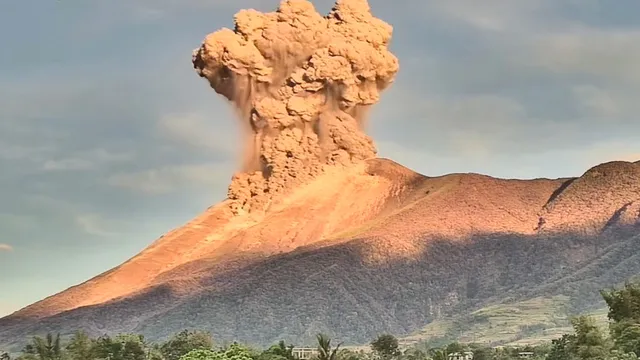
Mount Kanlaon erupts, forcing school closures in the Philippines
2025-04-08 13:47- Mount Kanlaon erupted, sending ash and debris into the sky, prompting school closures.
- Authorities suspended classes due to ashfall, affecting several villages in the region.
- Despite the eruption, local officials report that preparedness from previous events helped minimize risks.
Express your sentiment!
Insights
Yesterday, a significant volcanic event occurred in the Philippines as Mount Kanlaon, located on Negros Island, erupted and produced a towering plume of ash that soared up to 4,000 meters above the summit. The eruption began at approximately 5:51 AM local time and lasted for nearly an hour, concluding at 6:47 AM. The ash cloud drifted southwestward, affecting several communities and prompting local authorities to implement precautionary measures. School classes were suspended in at least four villages as a result of the ashfall, highlighting the volcano's potential impact on local residents and the education system. The eruption follows a history of activity from Mount Kanlaon, which is recognized as one of the Philippines' most active volcanoes. While there were no immediate reports of injuries or significant damage, the Philippine Institute of Volcanology and Seismology (Phivolcs) indicated that the area remains under careful surveillance due to the volcano's continued signs of unrest. Residents in the surrounding areas had already been evacuated following a previous eruption in December, which helped mitigate the risks associated with this latest event. Philippine chief volcanologist Teresito Bacolcol reassured the public that while alert level 3—indicating a high level of volcanic unrest—remains in effect, there were no accompanying signs such as a spike in volcanic earthquakes that would elevate the alert status to level 4 or 5, the latter indicating hazardous eruptions. Despite this, Bacolcol urged residents to stay vigilant and avoid areas within a 6-kilometer danger zone surrounding the volcano. As part of broader geological trends, the Philippines sits along the Pacific 'Ring of Fire,' an area known for its seismic activity that makes the region particularly susceptible to volcanic eruptions. In the past, incidents involving Mount Kanlaon have led to serious evacuations and impacts on local communities, emphasizing the necessity for preparedness and responsiveness from both government officials and residents in the vicinity of the volcano.
Contexts
The volcanic activity in the Philippines poses significant challenges to national safety and environmental stability. The Philippine archipelago is situated on the Pacific Ring of Fire, a region known for its tectonic activity that includes numerous active volcanoes. Among these, Mayon, Taal, and Pinatubo are some of the most prominent. Each of these volcanoes has a history of significant eruptions, leading to the displacement of populations, destruction of property, and loss of life. The variability and unpredictability of volcanic activity in the region necessitate the implementation of effective monitoring systems to ensure timely warnings and to mitigate the risks associated with eruptions. It is crucial to employ advanced geological and remote sensing technologies to track volcanic movements and seismic activity, enabling scientists to provide accurate forecasts and to guide disaster preparedness measures. In light of these challenges, the Philippine government, in collaboration with various international organizations, has developed a comprehensive framework for volcanic risk management. This framework includes public awareness campaigns, evacuation plans, and the establishment of designated safe zones around high-risk areas. Additionally, community training programs are conducted to educate the populace on the signs of an impending eruption and the necessary actions to take in the event of an emergency. Emergency response teams are also regularly trained and equipped to respond swiftly to volcanic incidents, ensuring that immediate assistance can be provided to affected areas. The integration of local knowledge and community involvement is vital to the success of these initiatives, as it fosters resilience among populations that are prone to volcanic hazards. Furthermore, research plays a critical role in enhancing our understanding of volcanic behavior and improving safety measures. Studies focus on the geological characteristics of volcanoes, historical eruption patterns, and the impacts of past events on communities and the environment. Collaborations with academic institutions and international research bodies contribute to the development of new technologies for early detection and risk assessment. These research efforts are essential for evolving strategies that better protect communities at risk, ultimately minimizing the social, economic, and environmental toll that volcanic eruptions can inflict. In conclusion, the Philippines' unique geographical location necessitates a proactive approach to volcanic safety. Continuous advancements in monitoring technology, alongside community engagement and research development, form the foundation of a robust volcanic risk management system. By prioritizing preparedness and response strategies, the Philippines can enhance its resilience against the devastating effects of volcanic eruptions, safeguarding both lives and livelihoods in the face of nature's unpredictability.